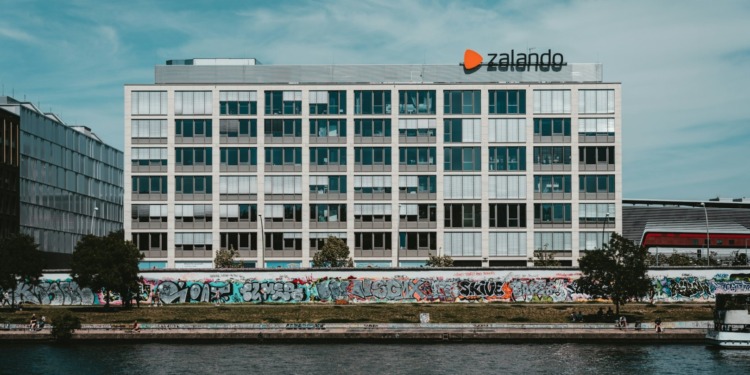An online fashion retailer specializing in clothing, accessories, and beauty products, Zalando doesn’t make its own products. Instead, it sells items from fashion companies big and small, from Bershka and PULL&BEAR to Puma and Yamamay. This makes it somewhat tricky to tell how sustainable Zalando is.
The company has become increasingly popular and is now one of the largest e-commerce businesses in Europe, where the company operates. And while the company mostly operates online, it owns a handful of physical stores in Germany.
To figure out how sustainable Zalando is, we need to define what sustainable means. Is it enough to grant reasonable shipping conditions, use recycled material, and give customers repair and resell services? Or should Zalando also select its partners, the brands it sells on its website, according to their sustainability efforts?
Zalando sustainability commitments
Looking at Zalando’s website, it seems clear that the company is making a real effort to be more sustainable. Among Zalando’s main commitments is an 80% reduction in emissions by 2025, compared to 2017 emissions. The company also promises to minimize waste in packaging and minimize single-use plastic use.
Zalando will work with more sustainable brands in the future, making sure 90% of partners have sustainable goals by 2025, a number currently stuck at 50%.
That said, those promised emission reductions mostly apply to Scope 1 and Scope 2, which are emissions generated by the company. Meanwhile, information about Scope 3 emissions appears to be absent from the company’s “Sustainable Strategy” page.
So where does that leave Scope 3 emissions?
Is Zalando reducing Scope 3 emissions?
Scope 3 emissions, which cover everything the company doesn’t produce but which is part of its value chain, are extremely important for an e-commerce brand like Zalando. As revealed by the company’s 2022 sustainability report, they account for 99.9% of their emissions.
When it comes to Scope 3, the company says it follows science-based commitments and has the following Scope 3 emissions reduction pledge:
“Zalando commits to reducing Scope 3 GHG emissions from private label products by 40% per million euro gross profit by 2025, from a 2018 base year.”
Zalando’s Scope 3 emissions have been steadily rising since 2017, as the company’s 2019 annual report shows, year by year. Newer reports confirm this upward trend: Overall, the company’s Scope 3 emissions went from 183.425 metric tons of CO2 in 2017, to 5.881.358 in 2022.
The company claims that emissions per order have gone down significantly, but is that really enough? Zalando still profits from this pollution. It needs to pollute less to turn a profit, but since it makes more of a profit, it pollutes more than before.
Zalando sustainability achievements
Zalando has achieved significant sustainability goals in the last few years. It has reduced Scope 1 and 2 emissions by 78% since 2017 and is now moving towards using 100% renewable electricity. In the same timeframe, its single plastic use in packaging shrank by 37%.
Meanwhile, the paper used in shipping boxes is already 99% recycled and uses 89% recycled material. Shipping bags and polybags similarly come from recycled plastic. In some countries (Finland, Norway, Sweden, and Denmark), some products even come in reusable bags, avoiding even this step of waste production.
Related Articles: How Sustainable Is Louis Vuitton? | Is Balenciaga Sustainable? | Greenwashing Is Trending, but It Shouldn’t Be!
Sustainable products in Zalando’s lineup grew from 140.000 in 2021 to 180.000 in 2022, though it’s unclear if this is higher, lower, or in line with the increase in unsustainable products offered.
Zalando also began collaborating with Circular.fashion, co-developing Circular Desing Criteria. Those criteria increase the life of all involved products, making them last longer, making repair easier, and inviting recycling.
Care and repair services at Zalando
The company doesn’t offer repairs currently. While the pilot project is being completed, it’s still unclear when (or if) the company will establish a permanent repair service. In 2020, the company launched a pilot for a repair system with Circular.fashion.
Every item on the website’s own label, ZIGN, included instructions for how to care for, repair, and resell the product. In the future, the project might be available for other products, too.
ZIGN itself is focused on sustainability. The company even uses it to try new circular design approaches, as well as new materials.
For the time being, it’s important to remember that there’s no reason to limit ourselves to the services offered by this business. Repairs can and are often made by third parties: local shops and online businesses alike. And as long as the product is solid, a good fix is often cheaper than buying new.
Editor’s Note: The opinions expressed here by the authors are their own, not those of Impakter.com — In the Featured Photo: Zalando building in Berlin, Germany. Featured Photo Credit: Claudio Schwarz.










